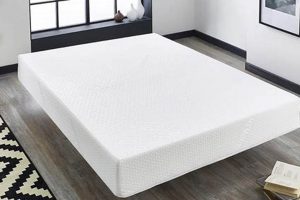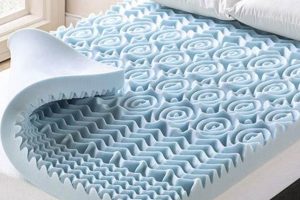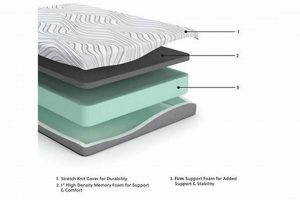The feasibility of altering the dimensions of viscoelastic polyurethane foam bedding is a common inquiry. This stems from situations requiring customization for specific bed frames, RVs, or achieving a particular comfort level through material reduction.
Adjusting the size of such a mattress presents opportunities for tailored sleep solutions. Historically, individuals have sought methods to modify bedding to accommodate unique needs, ranging from crafting specialized supports to fitting mattresses into irregularly shaped spaces. However, the process warrants careful consideration due to potential impacts on structural integrity and warranty.
Understanding the required tools, techniques, and potential consequences is vital before attempting any modification. The following sections detail essential aspects involved in modifying a viscoelastic polyurethane foam mattress, including considerations for preserving its intended performance and longevity.
Tips for Modifying Viscoelastic Polyurethane Foam Bedding
Effective alteration of a viscoelastic polyurethane foam mattress necessitates careful planning and precise execution. The following guidelines offer strategies for a successful modification process.
Tip 1: Thoroughly Assess Needs: Prior to any action, meticulously measure the target area and determine the precise amount of material that requires removal. Accurate measurements are crucial for achieving the desired fit and avoiding irreversible errors.
Tip 2: Employ Appropriate Tools: A sharp, long-bladed knife, ideally an electric carving knife, is recommended. This minimizes tearing and allows for cleaner, more controlled cuts compared to standard utility knives or scissors.
Tip 3: Mark Cutting Lines Clearly: Utilize a marker or chalk to delineate the intended cutting lines on the surface of the mattress. Straight, well-defined lines serve as a visual guide and enhance cutting accuracy.
Tip 4: Proceed with Slow, Deliberate Cuts: Exercise patience and cut gradually, following the marked lines. Avoid applying excessive pressure, which can distort the foam and lead to uneven results. Multiple passes may be necessary for thicker mattresses.
Tip 5: Maintain a Clean Workspace: Work in a well-ventilated area and protect the surrounding surfaces with drop cloths. Viscoelastic polyurethane foam particles can be messy and difficult to clean.
Tip 6: Consider Professional Assistance: For complex modifications or if uncertainty exists, consult a professional upholstery service. Their expertise can ensure a precise and structurally sound alteration.
Tip 7: Securely Reattach the Mattress Cover: After modification, carefully reattach or resew the mattress cover to prevent foam degradation and maintain structural integrity. Consider using a heavy-duty zipper for easy removal and cleaning.
Implementing these tips can help minimize the risk of damage and ensure the longevity of the modified viscoelastic polyurethane foam mattress. Accurate measurement and precision tools are crucial for a successful outcome.
The subsequent sections delve into the potential effects on warranty coverage and alternative solutions to consider before undertaking a permanent alteration.
1. Feasibility
The practical possibility of altering a viscoelastic polyurethane foam mattress through cutting hinges significantly on several factors. These include the desired extent of modification, the equipment available, and the skill of the individual performing the alteration. While technically possible to dissect such a mattress, the degree of success depends on carefully evaluating these elements before commencing. Failure to consider these aspects can lead to damage, rendering the mattress unusable. For example, attempting to remove a large section from the center of the mattress is less feasible than trimming a few inches from the edge due to the impact on structural support.
A critical element in determining viability is the evaluation of potential consequences. Cutting into a viscoelastic polyurethane foam mattress may compromise its structural integrity, leading to uneven support and reduced comfort. The density and layering of the foam significantly influence this outcome; mattresses with multiple layers of varying densities are more prone to deformation after modification. Furthermore, the tools employed play a vital role. Using inadequate cutting instruments can result in jagged edges and material tearing, negatively impacting the mattress’s functionality and aesthetics. Real-world examples illustrate this; modifications performed with professional-grade equipment and expertise often yield better results than those attempted with household tools.
In summary, the feasibility of altering viscoelastic polyurethane foam bedding by cutting is not absolute; it’s contingent on a thorough assessment of multiple factors. While the prospect of customization might seem appealing, understanding the potential risks and limitations is paramount. If uncertainty exists regarding one’s ability to execute the alteration successfully, seeking professional assistance is strongly recommended. Evaluating this aspect before proceeding preserves the mattress’s performance and longevity and aligns with responsible decision-making.
2. Tool Selection
The viability of altering viscoelastic polyurethane foam mattresses is inextricably linked to the selection of appropriate tools. Tool selection directly influences the precision, cleanliness, and overall success of the modification. Inadequate tools can result in uneven cuts, material tearing, and structural damage, rendering the mattress uncomfortable and unusable. Conversely, the correct tools facilitate smooth, precise alterations, preserving the mattress’s integrity and extending its lifespan. For example, utilizing a dull utility knife often leads to jagged, uneven cuts, while employing an electric carving knife allows for a cleaner, more controlled separation of the foam layers.
The importance of tool selection extends beyond the immediate cutting process. The tools used also impact the long-term durability of the modified mattress. Rough or uneven cuts create stress points within the foam, accelerating degradation and reducing the mattress’s overall lifespan. Furthermore, incorrect tool usage can damage the surrounding mattress components, such as the cover or underlying support layers. Professional upholstery services understand this connection intimately; they invest in specialized equipment to ensure the highest quality results and minimize the risk of damage. They use rotary cutters, industrial sewing machines, and other specialized tools to modify bedding in ways that the common homeowner cannot due to their equipment and years of experience.
In summary, tool selection is not merely a preliminary step but a critical component in determining wh
ether the alteration of viscoelastic polyurethane foam bedding is successful and long-lasting. The selection of the appropriate tools requires consideration of the foam’s density, the desired cut’s complexity, and the user’s skill level. Neglecting this factor can lead to irreversible damage and compromise the mattress’s overall performance. Understanding this connection is essential for anyone considering modifying a viscoelastic polyurethane foam mattress.
3. Cutting Precision
The feasibility of altering a viscoelastic polyurethane foam mattress directly correlates with the precision of the cutting process. The achievable degree of accuracy significantly impacts the outcome, affecting the mattress’s structural integrity, comfort level, and overall usability. Imprecise cuts can lead to uneven surfaces, compromised support, and accelerated material degradation. Conversely, meticulous cuts minimize these risks, preserving the mattress’s intended performance characteristics. For example, an accurately measured and cleanly executed cut allows the mattress to fit into an irregularly shaped bed frame without sacrificing support or comfort.
The requirement for cutting precision extends beyond simply achieving the correct dimensions. It encompasses maintaining the integrity of the foam’s cellular structure and avoiding unnecessary compression or tearing during the cutting process. Actions must be taken to ensure that there are no issues with the bedding. Tools, techniques, and environmental controls contribute to the final result. The usage of a dull blade or inconsistent pressure results in uneven cuts and damaged foam cells, leading to localized areas of reduced support and increased wear. Professional upholstery services, as an example, employ specialized cutting equipment and techniques, such as vacuum tables and electric blades, to ensure even pressure and minimizing foam distortion during the cutting process.
In summary, cutting precision is not merely a desirable aspect of altering a viscoelastic polyurethane foam mattress, but a critical determinant of its success or failure. The achievable degree of accuracy affects the mattress’s structural integrity, comfort, and longevity. Recognizing this significance allows individuals to make informed decisions regarding modifying the mattress and to employ techniques that minimize the risk of damage. Prioritizing cutting precision improves the chances of achieving the desired outcome and prolongs the useful life of the modified mattress.
4. Structural Impact
Altering a viscoelastic polyurethane foam mattress through cutting invariably affects its structural integrity. The degree and nature of this impact depend on several factors, including the extent of the modification, the location of the cut, and the internal construction of the mattress itself. Removing material from a support layer, for instance, will reduce the overall firmness and can lead to localized sagging over time. Cutting into a zoned support system, which is designed to provide varying levels of support to different areas of the body, can disrupt the intended distribution of pressure and compromise comfort. The cause-and-effect relationship is direct: material removal equals reduced structural support and potentially diminished performance. This understanding is crucial when assessing the feasibility of such modifications.
Practical significance lies in understanding how the structural impact will manifest after the alteration. For example, if a mattress is cut to fit a smaller bed frame, the edges where the cuts were made are more susceptible to wear and tear due to the exposed foam and compromised structural support. This can lead to edge collapse over time. Similarly, cutting a mattress to reduce its thickness can significantly alter its compression characteristics, potentially rendering it too soft or unsuitable for individuals requiring firmer support. Careful planning and consideration of these potential consequences are therefore essential before undertaking any modification. The structural impact, in essence, dictates the usable life and comfort level of the altered mattress.
In summary, any decision to modify a viscoelastic polyurethane foam mattress by cutting should be preceded by a thorough evaluation of the potential structural consequences. Ignoring this aspect can lead to unintended and irreversible damage, rendering the mattress unusable or significantly reducing its lifespan and performance. Prioritizing structural integrity through careful planning and precise execution is paramount for a successful alteration. The long-term implications on support, comfort, and durability must be carefully weighed against the perceived benefits of the modification.
5. Warranty Voidance
Altering a viscoelastic polyurethane foam mattress by cutting introduces a significant risk of voiding the manufacturer’s warranty. Mattress warranties typically cover defects in materials and workmanship under normal use conditions. Any modification to the product, including cutting, is generally considered outside of normal use and therefore grounds for warranty nullification. The direct connection is causal: the act of cutting the mattress removes it from the manufacturer’s original design and specifications, thus invalidating any guarantees made regarding its performance or longevity. The understanding of this risk is a fundamental component when considering alterations to viscoelastic polyurethane foam bedding.
Real-world examples illustrate this connection. Individuals who cut their mattresses to fit custom bed frames or to alter their firmness levels often find that any subsequent claims related to sagging, material breakdown, or other defects are rejected by the manufacturer. The warranty specifically excludes alterations, and evidence of cutting is readily apparent upon inspection. The practical significance of this understanding lies in the need to weigh the potential benefits of modifying the mattress against the loss of warranty coverage. The consumer must be fully aware of this trade-off before proceeding with any alteration.
In summary, the decision to cut a viscoelastic polyurethane foam mattress should be made with a clear understanding that such an action typically voids the manufacturer’s warranty. This voidance is a direct consequence of the alteration, removing the mattress from the conditions under which the warranty was originally offered. The long-term financial implications of this risk should be carefully considered, as any future repairs or replacements necessitated by defects will be the sole responsibility of the consumer.
6. Cover Reattachment
Cover reattachment is a crucial step following the alteration of a viscoelastic polyurethane foam mattress. Its significance stems from its impact on protecting the modified foam and maintaining the structural integrity of the bedding. It directly influences the lifespan and comfort of the customized mattress.
- Protection of Exposed Foam
Cutt
ing a viscoelastic polyurethane foam mattress exposes the inner foam to environmental factors such as dust, allergens, and moisture. Reattaching the cover acts as a barrier, shielding the foam from these elements and preventing premature degradation. Without a properly secured cover, the exposed foam can crumble and lose its supportive properties, leading to reduced comfort and longevity. - Maintenance of Structural Integrity
The cover contributes to the structural integrity of the mattress by holding the foam layers together and providing a uniform surface. After cutting, reattaching the cover helps to maintain this structure, preventing the foam from shifting or deforming over time. A loose or poorly attached cover can result in uneven support and a compromised sleeping surface.
- Aesthetic Considerations
A well-reattached cover not only protects the foam but also improves the overall aesthetic appearance of the mattress. A neatly sewn or secured cover gives the mattress a finished and professional look, enhancing its visual appeal. This is particularly important if the mattress is used without a separate mattress protector.
- Prevention of Allergen Accumulation
An intact cover helps to prevent the accumulation of allergens within the mattress. The cover acts as a filter, trapping dust mites, pet dander, and other allergens on its surface, where they can be easily removed through regular cleaning. A damaged or poorly attached cover allows these allergens to penetrate the foam, creating an unhealthy sleeping environment.
The importance of cover reattachment underscores the need for careful execution when altering a viscoelastic polyurethane foam mattress. A secure and properly fitted cover ensures the protection, structural integrity, and longevity of the modified bedding, maximizing its comfort and usability.
7. Alternative Solutions
Prior to altering a viscoelastic polyurethane foam mattress by cutting, exploring alternative solutions is prudent. These options often provide the desired outcome without compromising the mattress’s structure, warranty, or performance.
- Mattress Toppers
Mattress toppers offer a non-invasive means of adjusting the feel of a mattress. Available in varying thicknesses and materials, including memory foam and latex, toppers can add cushioning or firmness to achieve the desired comfort level. This avoids the irreversible nature of cutting and preserves the mattress’s original construction.
- Adjustable Bed Bases
Adjustable bed bases provide customizable support without altering the mattress itself. These bases allow users to elevate the head and feet, promoting comfort and alleviating pressure points. This addresses concerns about mattress shape and firmness without requiring any physical modification.
- Custom-Sized Bedding Components
Instead of altering a standard mattress, sourcing custom-sized bedding components may prove more effective. This involves obtaining sheets, mattress protectors, and other accessories that precisely fit the existing mattress dimensions. This ensures a snug and secure fit without resorting to cutting.
- Professional Upholstery Services
When a precise fit or specific modification is required, consulting a professional upholstery service is advisable. These services possess the expertise and equipment to alter a mattress in a controlled manner, minimizing the risk of damage and preserving its structural integrity. While more expensive than DIY solutions, this option provides a higher degree of accuracy and reduces the likelihood of voiding the warranty.
These alternative solutions address various reasons why individuals contemplate cutting a viscoelastic polyurethane foam mattress. Whether seeking increased comfort, a better fit for a specific bed frame, or enhanced support, these methods offer viable alternatives that avoid the risks associated with permanently altering the mattress.
Frequently Asked Questions
The following questions address common concerns and misconceptions surrounding the alteration of viscoelastic polyurethane foam mattresses.
Question 1: Is it possible to cut a memory foam mattress to fit a different size bed frame?
Modifying a viscoelastic polyurethane foam mattress dimensions is possible, however, it is subject to assessing structural integrity and ensuring proper tools and methods for cutting. The approach hinges on careful consideration, not simple action.
Question 2: What tools are best for cutting a memory foam mattress?
An electric carving knife with a long blade is generally recommended for achieving clean and precise cuts. A sharp utility knife can also be used, but extra care must be taken to avoid tearing or compressing the foam during the process. Tool selection is a determinant factor.
Question 3: Will cutting a memory foam mattress void the warranty?
Cutting a viscoelastic polyurethane foam mattress will almost certainly void the manufacturer’s warranty, as it constitutes a modification to the original product. Review the warranty terms of conditions before proceeding with any alterations.
Question 4: How does cutting affect the support and comfort of a memory foam mattress?
Cutting a viscoelastic polyurethane foam mattress can alter its support characteristics, especially if the cut compromises a zoned support system or removes a significant amount of material from the core. The result needs to be carefully measured. This result needs to be carefully weighed ahead of time.
Question 5: What should be done with the mattress cover after cutting a memory foam mattress?
After cutting a viscoelastic polyurethane foam mattress, the mattress cover must be carefully reattached or resewn to protect the exposed foam and maintain the mattress’s structural integrity. Not doing so can lead to the deterioration of foam.
Question 6: Are there alternative solutions besides cutting a memory foam mattress?
Alternatives to cutting a viscoelastic polyurethane foam mattress include using a mattress topper to adjust comfort, an adjustable bed base for customized support, or consulting a professional upholstery service for precise alterations. Before the cut consider all aspects and weigh alternatives.
In conclusion, while modifying a viscoelastic polyurethane foam mattress by cutting is technically feasible, it involves several risks and considerations. Carefully weighing these factors and exploring alternative solutions is essential before proceeding.
Considerations for the long-term performance should be at the front of thought.
Conclusion
The feasibility of altering viscoelastic polyurethane foam bedding by cutting presents a complex scenario. While physically possible, such modifications carry significant implications for structural integrity, warranty coverage, and overall performance. The exploration has demonstrated the need for careful planning, proper tool selection, and a thorough understanding of the potential consequences.
Ultimately, the decision to modify viscoelastic polyurethane foam bedding via cutting should be approached with informed awareness. Alternative solutions warrant exploration before committing to irreversible alterations. Responsible modification requires a careful evaluation of the trade-offs between desired customization and potential long-t
erm compromises. Any alteration made is the responsibilty of the user.



![Best Memory Foam Mattress Queen Walmart [Deals!] Organic & Natural Mattress Buyer’s Guide: Non-Toxic Sleep Solutions Best Memory Foam Mattress Queen Walmart [Deals!] | Organic & Natural Mattress Buyer’s Guide: Non-Toxic Sleep Solutions](https://mattressworldpa.com/wp-content/uploads/2025/07/th-3980-300x200.jpg)


![Best Memory Foam King Size Mattress [Guide & Reviews] Organic & Natural Mattress Buyer’s Guide: Non-Toxic Sleep Solutions Best Memory Foam King Size Mattress [Guide & Reviews] | Organic & Natural Mattress Buyer’s Guide: Non-Toxic Sleep Solutions](https://mattressworldpa.com/wp-content/uploads/2025/07/th-3977-300x200.jpg)
